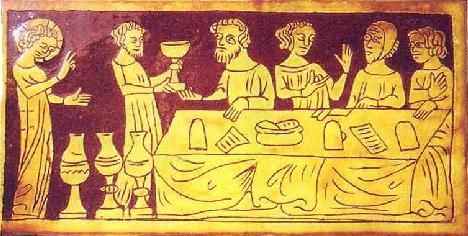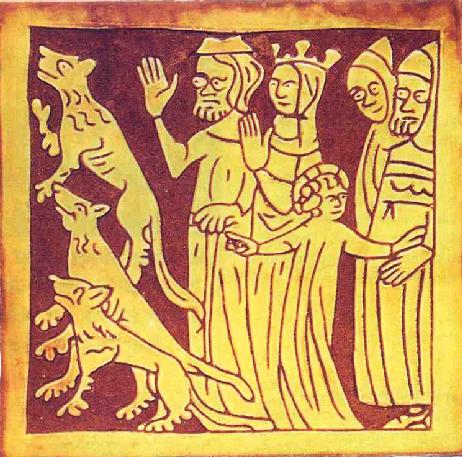|
by
WENDY AUSTIN
Reproduced by kind permission of the author.

Above: Jesus blesses the company at a family
feast.
Below: Lion cubs with Jesus. Mary and Joseph stand behind Him.
Jesus says: “These beasts know me: but men know me not.”

IN a Special Wall cabinet in the Medieval Galleries of the British
Museum there is a set of ceramic tiles unique in this country.
They were discovered during the late Victorian restoration of Tring
Parish Church and were immediately spirited away by persons unknown
to pass through many hands before achieving their final, and
deserved, august home.
The tiles are so important that one was chosen as the cover
illustration for a book published by the British Museum — English
Medieval Tiles by Elizabeth Eames. They date from the 14th
century and were made using a technique known as sgraffito,
even at the time an expensive hand-worked process. The brown
tile was coated with white slip; the decoration was incised with
lines; the slip was removed delicately from the background using a
small gouge; and a yellow design remained, separated from the
surface colour. Although known in France, no other tiles using
this type of decoration have ever been found in Britain, and it is a
mystery why they should have been used at Tring. Tiles
decorated in a similar, though not identical, technique are to be
found in Prior Crauden’s Chapel (built between 1321 and 1341) at Ely
Cathedral.
Their Condition is very good, and it is thought that the tiles were
used not on the floor but sited on the walls of the chancel.
They were covered by some drastic alterations in the first quarter
of the 18th century when the church was ‘wainscoted and beautified
in a most elegant manner’ by the then owner of Tring Park estate,
William Gore. As in everything, fashions in church
architecture change, and these 18th century ‘improvements’ were
stripped out in the early 1880s.
The tiles were then removed and offered for sale at a Curiosity Shop
in the town. Here they were purchased for a few shillings by a
Reverend Owen, rector of a nearby parish. He asked the owner
of the shop several times how he acquired the tiles, but the man
would never say. Reverend Owen later moved to Essex and when
his son died in 1922, the contents of Bramwell Rectory were
dispersed in a sale of household effects. An antiques dealer
from Chelmsford bought the tiles for £17 and then offered them for
auction at Sothebys. They were acquired by the British Museum
for £1,420, ensuring a staggering profit for the dealer.
Two more were presented by a Tring resident to the Victoria & Albert
Museum in 1927. After the restorations and at intervals over
the years, some Tring residents owning large properties, reported
finding fragments of medieval tiles during the demolition of garden
walls and paths. As stated the tiles appeared unworn, bearing
out the theory that they could have been used as a frieze rather
than on the floor. A frieze of this type can he seen on a
screen in the Malvern Priory Church.
The tiles carry attractive, and to modern eyes, humorous designs of
scenes from the childhood of Jesus taken from Apocryphal Gospels
[footnote] popular in the 14th century. The pictures are
similar to illustrations in a French manuscript now in the Bodleian
Library, but are not direct copies of them. Some depict the
young Christ performing miraculous acts, but others are simply
bizarre, such as ‘Children shut in an oven to stop them playing with
Jesus’. One superb double tile depicts Him blessing a family
feast.
Some years ago Tring Local History Society took the decision to
commission a specialist potter, Chris Cox of Ironbridge, to copy the
design and to make a complete set of the tiles. It was
intended these should be displayed for all to see in their original
home of St. Peter & St. Paul’s Church at Tring.
More research into the origins of the tiles needs to be done, for
the mystery is still far from solved. But it is quite possible
that we may never know who made the tiles, how they came to England;
why they were placed in Tring Church; and who actually removed them.
――――♦――――
FOOTNOTE
In everyday conversation “apocryphal” refers to a story of doubtful
authenticity, but one that is nevertheless told frequently, perhaps
even believed widely. The New Testament apocrypha are books
accepted by neither Catholic nor Protestant faiths, although artists
and theologians have used them as sources of information and ideas.
They include several surviving “Infancy Gospels”, literature created
in the early Christian church to satisfy the need for details about
the childhood life of Jesus. For example, the Infancy Gospel
of Thomas — he of “Doubting Thomas” fame — describes the doings of
Jesus during his boyhood, no record of which exists in the canonical
gospels. According to Thomas, Jesus proved to be an infant
prodigy at school, instructing his teachers in the unsuspected
mysteries of the alphabet and astonishing his family and friends by
the miracles that he performed. Scenes such as these are depicted in
the Tring Tiles.
――――♦―――― |
